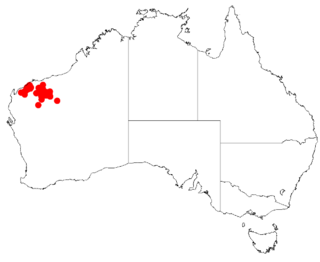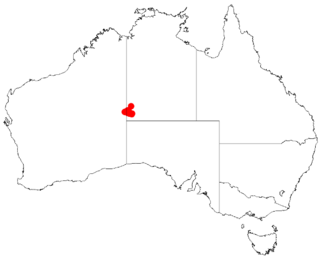
Acacia atkinsiana, commonly known as Atkin's wattle, is a shrub belonging to the genus Acacia and the subgenus Juliflorae endemic to Australia. The indigenous peoples of the area where the shrub is found, the Kurrama peoples, know the shrub as Bilari or Pilarri.

Acacia bromilowiana, commonly known as Bromilow's wattle, is a tree belonging to the genus Acacia and the subgenus Juliflorae that is endemic to a small part of north western Australia.
Acacia diallaga is a shrub belonging to the genus Acacia and the subgenus Juliflorae that is endemic to Western Australia.
Acacia gibsonii, commonly known as Gibson's wattle, is a shrub belonging to the genus Acacia and the subgenus Juliflorae.

Acacia hamersleyensis, also known as Karijini wattle or Hamersley Range wattle, is a tree or shrub belonging to the genus Acacia and the subgenus Juliflorae. It is endemic to a small area in central Western Australia.

Acacia latior is a shrub belonging to the genus Acacia and the subgenus Juliflorae that is endemic to western Australia.

Acacia rhodophloia, commonly known as minni ritchi or western red mulga, is a tree or shrub belonging to the genus Acacia and the subgenus Juliflorae that is endemic to a large area of arid central western Australia. The Indigenous group the Kurrama peoples know the plant as mantaru.

Acacia thoma is a shrub belonging to the genus Acacia and the subgenus Juliflorae that is endemic to arid areas of western Australia.

Acacia yorkrakinensis is a shrub belonging to the genus Acacia and the subgenus Juliflorae that is native to Western Australia.

Acacia marramamba, commonly known as marramamba, is a shrub or tree belonging to the genus Acacia and the subgenus Phyllodineae that is endemic to arid parts of western Australia.
Acacia muriculata, commonly known as Koolanooka wattle, is a shrub belonging to the genus Acacia and the subgenus Phyllodineae that is endemic to a small area of south western Australia.

Acacia pusilla is a shrub of the genus Acacia and the subgenus Phyllodineae the is endemic to south western Australia.

Acacia scleroclada is a shrub of the genus Acacia and the subgenus Phyllodineae that is endemic to an area of western Australia.

Acacia simulans is a shrub of the genus Acacia and the subgenus Phyllodineae that is endemic to south western Australia.
Acacia anserina, also known as hairy sandstone wattle, is a shrub of the genus Acacia and the subgenus Plurinerves. It is native to a small area in the Kimberley region of Western Australia.

Acacia arrecta, commonly known as Yarnda Nyirra wattle or Fortescue wattle, is a shrub of the genus Acacia and the subgenus Plurinerves that is endemic to arid areas in north western Australia.

Acacia ascendens is a shrub of the genus Acacia and the subgenus Plurinerves that is endemic to a small area in south western Australia.

Acacia auricoma, commonly known as Petermann wattle, Alumaru and Nyalpilintji wattle is a shrub of the genus Acacia and the subgenus Plurinerves. It is native to an area in the Northern Territory and the eastern Goldfields region of Western Australia.

Acacia lanuginophylla, or woolly wattle, is a shrub of the genus Acacia and the subgenus Plurinerves that is endemic to south western Australia. It is currently listed as a vulnerable species according to the Environment Protection Biodiversity Conservation Act 1999.
Acacia exilis, commonly known as muntalkura wattle, is a species of wattle belonging to the genus Acacia and the subgenus Juliflorae. The Kurrama peoples know the tree as jonanyong or jananyung. It is native to an area of the Pilbara region of Western Australia.
















